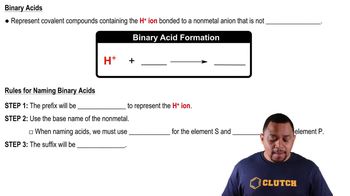Here are the essential concepts you must grasp in order to answer the question correctly.
Carboxylic Acids
Carboxylic acids are organic compounds characterized by the presence of a carboxyl group (-COOH). They are known for their acidic properties due to the ability of the carboxyl group to donate a proton (H+). In reactions, carboxylic acids can undergo esterification, where they react with alcohols to form esters and water, often in the presence of an acid catalyst.
Recommended video:
Rules for Naming Carboxylic Acids
Esterification Reaction
Esterification is a chemical reaction between a carboxylic acid and an alcohol, resulting in the formation of an ester and water. This reaction typically requires an acid catalyst, such as sulfuric acid, to proceed efficiently. The general equation for this reaction is: Carboxylic Acid + Alcohol ⇌ Ester + Water, highlighting the reversible nature of the process.
Recommended video:
Ester Reactions: Esterification
Role of Sulfuric Acid
Sulfuric acid (H2SO4) serves as a strong acid catalyst in esterification reactions. It not only protonates the carboxylic acid, enhancing its electrophilicity, but also helps to remove water produced during the reaction, driving the equilibrium towards ester formation. This catalytic role is crucial for increasing the reaction rate and yield of the desired ester product.
Recommended video:




